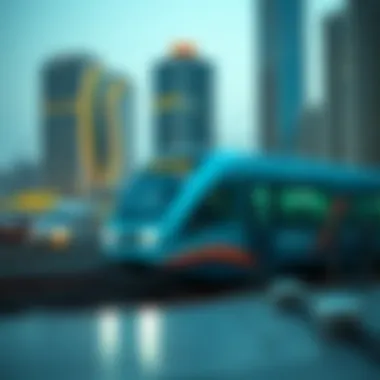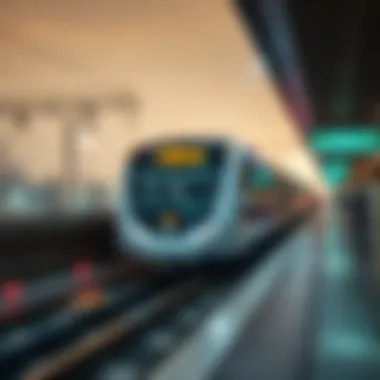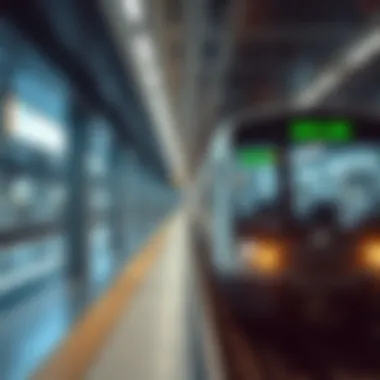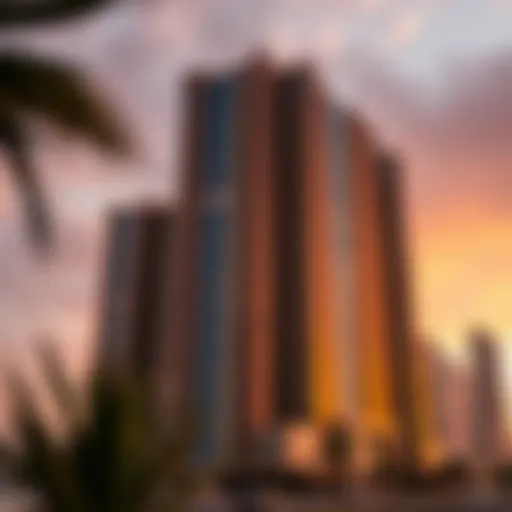Examining the Financial Aspects of Dubai's Metro System


Intro
The Dubai Metro system stands as a hallmark of modern urban transport, spanning over 90 kilometers and connecting various parts of this bustling metropolis. It is vital to analyze the cost dynamics associated with this transportation marvel, as it not only serves commuters but also impacts the broader urban landscape including real estate and infrastructure.
Understanding the cost structure of the Dubai Metro involves delving into fare systems, operational expenses, and how these elements interconnect. Whether you are an investor looking to capitalize on changing property values, a homeowner seeking efficient transport solutions, or a tourist wanting to navigate the city effortlessly, the costing details of Dubai Metro hold significance.
In this article, we will dissect various elements that shape the costs tied to this essential transport network. We will also explore how these costs influence urban mobility and the real estate scene in Dubai. Through our examination, we'll connect the dots between commuter habits and economic viability, creating a full picture that is relevant to stakeholders in the city’s bustling market.
Market Trends
Current Market Analysis
The Dubai Metro has impacted the urban fabric of the city in numerous ways. As transportation fees are aligned with international standards, they are attractive for both frequent commuters and tourists alike. The pricing strategy includes tiered zoning based on distance traveled, making it flexible and manageable for users. This offers prospective residents insights into living near metro stations, as their proximity oftentimes correlates with an increase in property value.
The added convenience of public transport encourages real estate development in areas adjacent to metro stations. Consequently, the entire spectrum of the housing market, ranging from high-end condominiums to more affordable housing options, experiences a ripple effect in pricing and demand.
- Key considerations include:
- Fare structures that attract daily users
- Increasing property values around metro stops
- Shift in commuter demographics due to accessibility
Future Predictions
Looking ahead, the market trends suggest that the impact of the metro on urban zoning will only increase. With ongoing expansions planned, including new lines that further connect peripheral neighborhoods, we can anticipate a more pronounced influence on nearby real estate prices.
Real estate experts predict that demand for properties within a 15-20 minute walk from metro stations will surge. Consequently, investors and homebuyers need to keep a keen eye on emerging neighborhoods that are slated for new metro access. Such foresight could translate into strategically advantageous acquisitions or improved rental yields.
"The metro not only alleviates traffic congestion but also serves as a catalyst for urban development and a boost for the economy."
Property Types
Residential Properties
Residential properties near metro stations tend to show robust demand due to the convenience of transport. Buyers are not just considering living space; they are investing in a lifestyle that prioritizes accessibility. Apartments and townhomes located within a short distance of Dubai Metro stops witness increased interest, often leading to higher valuation.
- Investment opportunities include:
- Newly constructed apartments near upcoming metro lines
- Established neighborhoods with existing connectivity
- Shared housing opportunities that cater to commuting expats
Commercial Properties
On the commercial front, businesses inherently thrive when located near efficient transport systems. Retail and office spaces close to metro stations tap into daily foot traffic from commuters.
- Areas to watch include:
- Mixed-use developments combining office spaces and retail near metro hubs
- Large shopping centers that attract visitors before or after their commute
- Flex spaces that cater to startups looking for high-visibility locations
Prelims to the Dubai Metro
The Dubai Metro has become a pivotal aspect of the city’s transportation landscape, marking significant strides towards urban mobility and sustainable development. As an ongoing project since its inception, it offers valuable lessons in infrastructure investment, fare structuring, and operational viability. Understanding the importance of the Dubai Metro extends beyond just transportation; it encompasses the economic dynamics within Dubai, the evolving expectations of its residents, and the experience of visitors drawn to the city’s booming real estate market. The topic at hand allows us to explore the multifaceted implications of the Metro system.
Overview of the Metro System
The Dubai Metro is renowned for its efficiency and modernity. Operated by the Roads and Transport Authority (RTA), this rapid transit system boasts two primary lines: the Red Line and the Green Line, covering a distance of approximately 90 kilometers combined. Operating since 2009, the Metro has adapted to the city's rapidly growing population and its intent to diversify its transportation options. With a total of 49 stations, many of which connect with major hubs such as Dubai Marina, Dubai International Airport, and the Dubai Mall, the Metro proves to be an essential artery of urban connectivity.
- Red Line: Runs parallel to the coast, connecting key residential and commercial areas.
- Green Line: Serves the more traditional parts of Dubai and intersects with the Red Line at key exchange stations.
The Metro offers state-of-the-art facilities, including free Wi-Fi, air-conditioned carriages, and easy accessibility for people with disabilities. Furthermore, its automated system guarantees punctuality and safety.
Historical Context


To appreciate the Metro’s current significance, it’s crucial to reflect on how this ambitious project came into being. The initiative was part of Dubai’s 2020 Urban Master Plan, introduced in response to the social and economic challenges posed by rapid urbanization. By 2000, Dubai’s population had begun to swell, and the need for effective public transport became increasingly pressing. Initially, ideas for a transport network were debated, but it wasn’t until the start of the 21st century that real traction was gained.
The construction of the initial 52 kilometers of the Metro, the longest fully automated system in the world, launched in 2006 amidst economic boom. Despite financial fluctuations, the project persisted, underscoring the Dubai government’s commitment to fostering advanced urban infrastructure. Today, the historical trajectory of the Dubai Metro represents both an investment in public transit and a reflection of Dubai’s vision to remain ahead in the global economic race.
"Investing in urban transport systems like the Dubai Metro is crucial; they accelerate economic growth, enhance connectivity, and ultimately shape the city's future."
By dissecting the fare structures and operational expenses, we can further unravel the intricate layers that contribute to the Metro system's effectiveness and sustainability. Such an analysis not only aids in assessing the overall cost implications but also sheds light on how the Dubai Metro interplays with fluctuating economic conditions and the broader urban landscape.
Fare Structure of the Dubai Metro
When delving into the financial ecosystem of the Dubai Metro, the fare structure stands as a fundamental pillar. Not only does it dictate the immediate cost to the user, but it also reflects broader economic strategies and urban planning initiatives. A well-thought-out fare system encourages both residents and tourists to utilize public transport, thus easing congestion on roads and promoting more sustainable urban mobility.
Types of Tickets Available
Standard Tickets
The Standard Tickets for the Dubai Metro offer a straightforward option for users. With its clarity and simplicity, it stands out as a favored choice among many commuters. Users can purchase these tickets from the various vending machines or ticket booths scattered across stations.
Unlike some complex fare systems seen in other cities, the pricing for Standard Tickets remains consistent, making it easy for passengers to plan their journeys. A unique feature of this type is that it functions on a pay-as-you-go basis. Customers only need to tap the ticket on entry and exit, keeping transactions seamless and quick. However, potential downsides include costs that might stack up for daily users compared to more integrated ticketing options.
Daily Passes
Daily Passes cater to individuals who want a bit more freedom during their travel day. This ticket allows unlimited rides within 24 hours which is fabulous for those planning to hop around the city, checking out sights or visiting multiple locations in a day. The appeal lies in its unrestricted access, giving users the ability to travel at will without clocking fares on each trip.
This flexibility can turn out to be a game-changer for tourists and even residents who might not typically rely on public transport. Besides, the cost of the Daily Pass becomes an attractive option for someone who might otherwise incur multiple Standard Ticket charges throughout the day. The catch here is that if a user only plans a couple of trips, a Daily Pass might end up feeling like money down the drain.
Monthly Passes
For Monthly Passes, the intended audience leans heavily toward the regular commuter. This ticket packaging enables consistent, reliable access to the Metro and promotes habitual use, which can lead to greater financial savings for those who ride multiple times a week.
One of the standout characteristics of the Monthly Pass is its ability to offer a more economical solution, particularly for those using the system daily or several times a week. On the downside, one must commit to the full month, which might not suit everyone’s schedule. Then, there’s also the challenge of identifying whether using the Metro will indeed align with personal commuting needs for that length of time.
Pricing Tiers
Red Line vs. Green Line Costs
Understanding the price tiers between the Red and the Green Lines gives further depth to the Metro's financial structure. The Red Line, spanning a longer distance, tends to cost more. Passengers can expect a broader range of fare prices based on the length of their journey. This means for tourists and long-distance commuters, the fares could induce varied financial approaches based on their travel needs.
On the flip side, the Green Line primarily serves to connect key areas that may not require extensive travel. Its reduced fare structure can encourage usage among those residing or working in nearby neighborhoods, fostering a sense of local community involvement with the Metro’s services. Balancing attractiveness between these two lines is essential for the Metro's operational strategy.
What Determines Fare Levels
Determining fare levels in the Dubai Metro system intertwines various components from economic principles to operational costs. Factors like distance traveled, the specific line utilized, and even peak vs. off-peak times come into play. The system utilizes a zone-based pricing model, where the more zones you cross, the higher the fare.
This method not only promotes fairness but also encourages mindful traveling habits, as users opt for more efficient routes. However, fare pricing must be meticulously adjusted over time, reflecting changes in both operating expenses and passenger demand. The balancing act here is critical as it impacts both the sustainability of the system and user satisfaction.
"A well-considered fare structure can transform urban mobility, making public transport an enticing choice for everyone."
By fostering understanding around the fare structure of the Dubai Metro, stakeholders can appreciate its implications not only for riders but also for the overall urban landscape.
Operational Costs and Financial Sustainability
Understanding the operational costs and financial sustainability of the Dubai Metro system is pivotal for various stakeholders—be it investors, residents, or policy-makers. This part of the article sheds light on the vital implications that the financial aspects have on the daily operations and long-term viability of this public transport network.
Infrastructure Maintenance Expenses
Infrastructure maintenance is a critical component in ensuring that the metro system operates smoothly. The costs associated with this maintenance include everything from regular inspections and repairs to complete overhauls of aging components. The expenditures can pile up quickly, not only in terms of monetary value but also in the resources needed for planning and logistics. For instance, the Dubai Metro runs on advanced technologies that require specialized knowledge and resources, making maintenance a task that can grow quite complex.
Routine checks are essential to prevent possible breakdowns or accidents, which can stall operations and cause inconveniences to commuters. Moreover, a well-maintained system directly influences the longevity of the metro itself, ensuring that it returns on investments made in its initial construction. Regular audits and modernization efforts also facilitate smoother operations which keeps ridership up, an important metric for financial sustainability.
Funding and Revenue Streams


A well-structured funding approach and diversified revenue streams are needed for the metro to sustain its operations and also to invest in future expansions. Understanding how money flows into the metro system gives insights into its resilience and capacity to adapt to changes in demand and future infrastructural needs.
Government Finances
Government funding plays a significant role in the financial health of the Dubai Metro. This funding can be seen as a foundational support system that ensures the trains run on time and that the stations are clean and functional. The unique feature of government financing lies in its ability to absorb unforeseen economic shocks - something that fare revenues alone cannot always achieve.
Such financing is often leveraged to initiate large-scale upgrades or expansions, effectively enhancing overall capacity. However, reliance on government funds poses its share of challenges. For one, it ties the metro's financial fate to public policy and budgeting decisions, which can vary substantially from year to year.
Public-Private Partnerships
Public-private partnerships, or PPPs, offer a different avenue for funding the metro system. This model encourages investments from private entities while distributing some operational risks across both sectors. This collaborative approach brings in efficiency and innovation often not found in traditional public financing. Highlights of PPPs include shared technology advances, faster project completion times, and reduced public expenditure on initial investments.
Nevertheless, while PPPs can greatly enhance operational efficiencies, they come with complexities, such as contractual negotiations and alignment of interests. They bring about a dynamic interplay between management styles, potentially leading to conflicts if not properly managed. The balancing act of public interest with profit motives becomes a subtle but essential aspect of such partnerships, making them both beneficial and challenging within the framework of the metro system.
Overall, examining these elements provides valuable perspective into how the operational costs and financial strategies are interwoven, impacting not just the system's current stability but also its future growth and development.
Comparative Analysis with Global Metro Systems
Understanding how the Dubai Metro stacks up against other global metro systems is not just an academic exercise; it's a vital part of evaluating its effectiveness, affordability, and reach. Urban transportation is the backbone of any bustling metropolis. By pulling back the curtain on how Dubai's system compares with others, we can glean insights about its operational efficiency, customer satisfaction, and economic impact.
Comparing Fare Structures
Cost per Ride in Major Cities
When we look at cost per ride in major cities around the world—think cities like London, Tokyo, and New York—Dubai's fare structure appears relatively moderate. In metropolitan hubs, prices can swing wildly; for instance, in London's Oyster system, fares can hit up to £5.50 for one trip. Meanwhile, a ride on the Dubai Metro often costs just a few dirhams, typically around AED 3-8, depending on distance traveled. This positions Dubai as a cost-friendly option for commuters.
One key characteristic of this cost-effective fare policy is its accessibility. Lower costs encourage ridership among all economic demographics, which helps reduce road congestion and promotes a more sustainable urban environment. However, contrasting this with cities like Paris reveals that lower fares might also come with trade-offs like limited service frequency, particularly in less populated zones. Thus, while the cost per ride in Dubai may attract users, service quality and availability play pivotal roles in shaping overall customer experience.
Cost Efficiency Metrics
Cost efficiency doesn't just hinge on fare prices; it encompasses the overall expenditure efficiency regarding service provided. The cost efficiency metrics of the Dubai Metro indicate a robust operational model. For example, when comparing costs per passenger per kilometer, the Dubai Metro fares well against counterparts like the New York Subway and the Tokyo Metro, where higher operational costs can lead to fare hikes.
A significant aspect of these metrics is their assistive role in urban planning. High efficiency suggests that the metro system effectively uses resources, enabling authorities to redirect funds toward service improvements. Uniquely, the Dubai Metro benefits from government backing, meaning that capital investments often see a quicker return due to high demand from tourists and residents alike. Yet, this relationship also risks dependency on government finances, making it essential to balance efficiency with financially sustainable models.
Assessing Service Quality
Beyond mere numbers, one must assess the quality of service provided. The user experience—punctuality, safety, cleanliness—paints a broader picture where ride cost intersects with overall satisfaction. In Dubai, with high-profile investments in modern trains and infrastructure improvements, commuters undoubtedly receive quality service, thus justifying the operating costs.
Overall, comparing the Dubai Metro to other global metro systems reveals much about the city’s transport strategy and its economic context. By appraising fare structures and service quality, we not only gain insight into the functionality of the metro but also its critical role in shaping Dubai's urban landscape.
Impact of Metro Costs on Residents and Tourists
The financial implications of the Dubai Metro system play a significant role not only in the daily lives of its residents but also in shaping the experiences of tourists. Understanding the cost aspects offers insights into how accessible and practical transportation is in this bustling city. It also reveals how the pricing strategy affects mobility and tourism—a noteworthy consideration for anyone involved in real estate or urban planning.
Accessibility for Residents
Affordable Transportation Options
Affordable transportation is a backbone of urban infrastructure, and the Dubai Metro's fare structure is seen as quite reasonable compared to other global systems. The ticket prices are generally lower than car ownership costs, including fuel and maintenance, making it a favorable alternative. One standout feature of these options is the Nol card, which provides discounts and makes transactions smooth for regular commuters.
Residents find the ease of accessing metro stations a game changer. With several lines crisscrossing the city, they can navigate easily without the stress of congested traffic. There’s no denying that this contributes to a more balanced urban ecosystem, making life more convenient for dwellers. However, it’s important to mention that while most residents appreciate the affordability, some do find themselves questioning the value of periodic fare increases, which can strain budgets.
Implications for Daily Commutes
Daily commutes significantly shape the day-to-day life of Dubai's residents. The affordability of travel via the metro means that many workers have a reliable and cost-effective means of transportation. This can lead to a more productive workforce and less time wasted in traffic. The characteristic here is its punctuality, with trains arriving at regular intervals, making it a reliable choice.
Moreover, the Metro's streamlined service encourages residents to shift from personal vehicles to public transport, fostering a cultural shift towards sustainable transport options. A potential drawback, however, is overcrowding during peak hours, which might be seen as a negative aspect of an otherwise well-functioning system.
Tourist Considerations


Cultural Impacts of Pricing
For tourists, the pricing of the Dubai Metro can have a profound cultural impact. The reasonable fares offer a glimpse into the city’s commitment to inclusivity and accessibility for all visitors. Affordable transport encourages exploration, allowing tourists to immerse themselves in diverse neighborhoods without worrying about racking up expenses.
Moreover, local tours integrated with metro travel can showcase the city's attractions, tying transport with cultural engagement. However, contrasting the local costs with those of tourist attractions might surface concerns over affordability. Some tourists may perceive a disparity between transport expenses and locale experiences, which could steer them away from some destinations.
Convenience and Travel Planning
The Dubai Metro stands out not just for its pricing but for its user-friendliness in travel planning. With information available in multiple languages, tourists can easily maneuver through the metro system with little to no language barrier. Moreover, mobile applications and interactive kiosks enhance navigation and ticket purchasing, making travel smooth.
Unique features like direct access to the airport help further solidify its role in travel itineraries. However, the limited reach in certain areas of the city can complicate plans, challenging tourists aiming to explore off-the-beaten-path locales.
In summary, the impact of metro costs must consider both residents and tourists, focusing on how these transport expenses shape urban life and travel experiences in Dubai.
Future Developments and Cost Implications
As the urban landscape of Dubai continues to evolve, the future developments within the Dubai Metro system are crucial to understanding its ongoing costs and the implications for various stakeholders. This section dives into the upcoming metro line expansions and the anticipated alterations in fare structures that stem from economic and technological changes.
Upcoming Metro Line Expansions
Dubai has ambitious plans to expand its Metro network further. With the urban sprawl, it's becoming essential to introduce new lines that integrate more neighborhoods into the metro system. These expansions are not just about increasing the reach; they also aim to enhance connectivity across the city, making life easier for both residents and tourists.
Already, plans are in place for a new line that will connect the existing Metro network to the Expo 2020 site, which could become a pivotal hub for future travelers. Additionally, there have been talks of extending the Red Line northward toward the emirates of Ajman and Sharjah.
The benefits of these expansions are manifold. A broader Metro system will help reduce traffic congestion, lower carbon emissions, and create more cost-effective commuting options. However, such projects require significant investment, which can lead to increased operational costs in the future.
Predicted Changes in Fare Structure
Effect of Economic Factors
The economic landscape in Dubai is changing, with fluctuations influenced by global market trends, the oil industry, and recovery from recent downturns, such as those brought on by the pandemic. As economic conditions vary, so do fare structures within the Metro system.
In a buoyant economy, fare increases may be on the table, allowing the system to sustain its investments and operational needs. On the flip side, during economic slowdowns, there might be calls to keep fares static or even reduce them to ensure affordability for everyday commuters.
This dynamic aspect of fare structure is significant because it reflects both the economic reality of the region and the need for the Metro to adapt. If fares remain too high amidst economic strain, public transport may become less attractive, leading to a potential decline in ridership. Conversely, affordable fares during prosperous times can boost the Metro's appeal, positively impacting urban mobility.
Influence of Technological Advancements
Technology is another game-changer when it comes to fare structures. Innovations such as contactless payment systems, mobile ticketing apps, and real-time tracking apps not only improve user convenience but also potentially lower operational costs. For instance, with automated fare collection systems, the Metro can reduce the need for physical ticket counters, ultimately saving on labor costs.
Moreover, advancements in artificial intelligence and data analytics can help Metro planners better understand passenger flow and optimize routes, leading to a more efficient service and better use of resources. These technological improvements could stabilize budgetary requirements and allow for more competitive pricing strategies.
In a nut shell, the increased reliance on technology can offer substantial advantages. It saves money by streamlining operations while improving customer experience, thereby drawing more riders and enhancing the Metro's overall economic viability.
To summarize, understanding the future developments and their cost implications is vital for outdoor investors, home buyers, real estate agents, property managers, and renters in evaluating how the Metro impacts their interests in Dubai's ever-evolving landscape.
For further insights, check additional resources on this topic at
Wikipedia
Britannica
Reddit
Dubai Government
Culmination
The Dubai Metro system serves as a pivotal component of the city's public transport framework, and understanding its multifaceted cost structure is essential for various stakeholders. From investors eyeing profit from real estate developments near metro stations to renters seeking accessible commuting options, each group finds a particular angle where metro dynamics affect their choices. The insights gleaned from the cost analysis are crucial in understanding its implications not just for transport but for the socio-economic fabric of Dubai.
Summary of Key Insights
Taking a step back to examine the key points from this article, several elements stand out:
- Fare Structure: The varying types of tickets, including standard tickets, daily passes, and monthly options, offer a flexible transportation choice, catering to diverse users. Pricing differences between the Red and Green lines also illustrate strategic economic planning accorded to the demand pattern.
- Operational Costs and Financial Sustainability: Addressing maintenance expenses is vital for the system's longevity. Additionally, how Dubai's government balances funding—through both public budgets and private partnerships—will determine the financial future of the metro.
- Impact on Residents and Tourists: For locals, affordability plays a key role in daily commutes, while tourists benefit from convenient transit options. The pricing affects not just mobility but the overall accessibility of key attractions.
- Future Developments: Upcoming metro expansions promise to enhance connectivity, potentially altering fare structures and operational methodologies based on technological advancements and economic conditions.
In essence, these insights coalesce to highlight the metro's importance, not only as a means of transportation but also as a catalyst for urban growth and economic prosperity.
Final Thoughts on the Economic Viability
Looking ahead, the economic viability of the Dubai Metro appears robust, contingent on effective management of its operational costs and continued investment in infrastructure. The culture of public transport is gradually being embraced, and in a city that thrives on tourism and expat communities, the metro system embodies a focal point of urban planning.
While challenges remain—such as fluctuating operational costs and the need for significant capital investment—the overarching benefits seem to outweigh potential setbacks. Properly harnessed, the Dubai Metro could very well play a significant role in shaping the future of urban mobility not just locally, but as a prototype for other cities facing similar expansion challenges.
In summary, for stakeholders like investors and city planners, the insights into the metro’s operation and costs highlight essential considerations. Engagement with its dynamics can result in informed decision-making that aligns with broader economic objectives and urban development goals.











